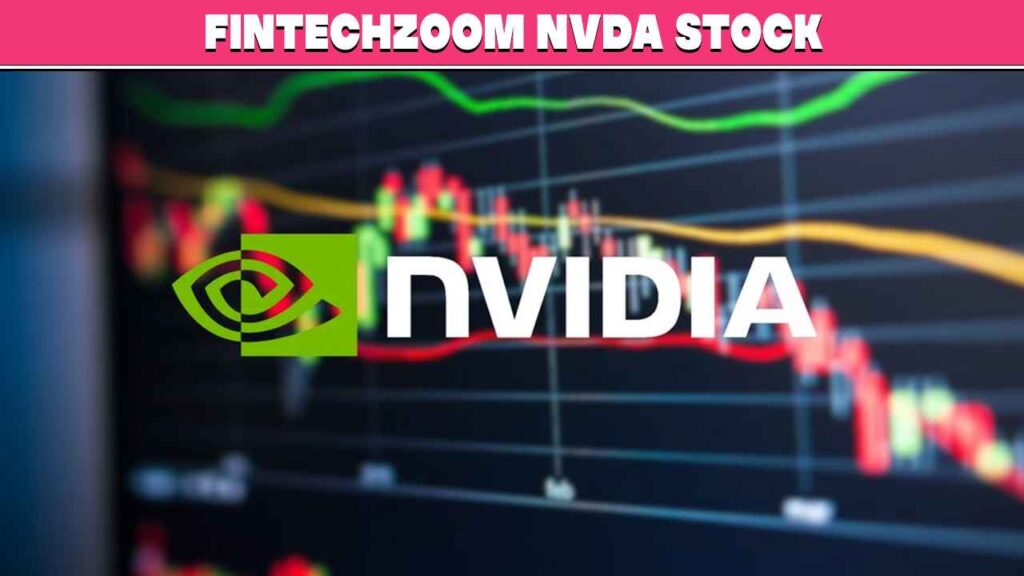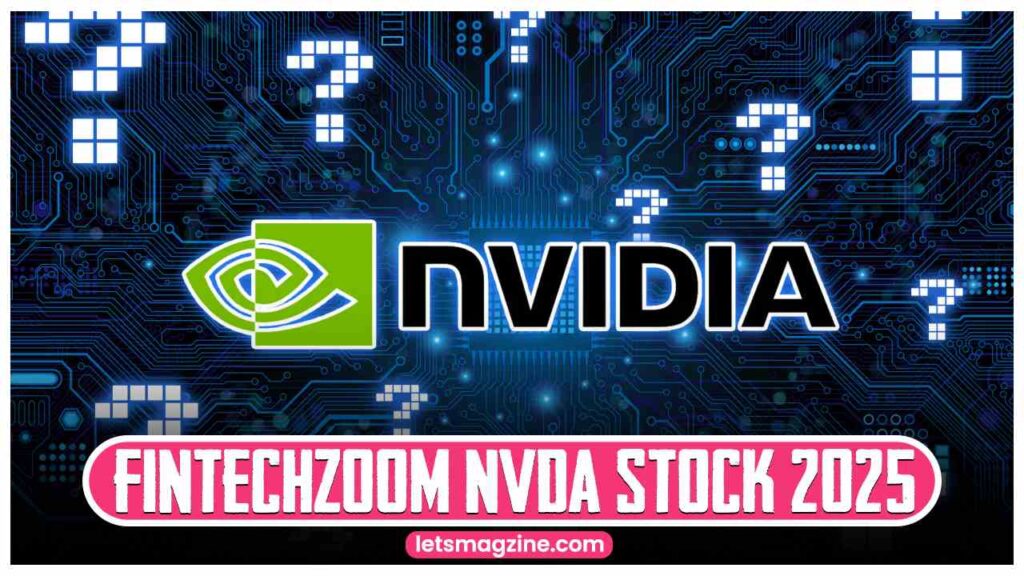NVIDIA (NVDA) has become a dominant force in the tech industry, making it an appealing stock for investors. As the company continues to lead advancements in AI, gaming, and cloud computing, its stock has attracted significant attention. With the year 2025 on the horizon, many are eager to understand what the future holds for NVDA.
The company’s robust portfolio of high-performance GPUs and cutting-edge technology positions it as a key player in industries like AI, autonomous vehicles, and gaming. As these sectors continue to grow, NVDA stands at the forefront of technological innovation.

What is Fintechzoom NVDA Stock?
Fintechzoom NVDA stock refers to the shares of NVIDIA Corporation, a global leader in graphics processing units (GPUs) and artificial intelligence (AI) solutions. These stocks represent ownership in a company that is at the forefront of technological advancements, especially in sectors like gaming, data centers, and autonomous driving.
As one of the most valuable companies in the world, NVDA has gained significant attention from investors. The company’s stock performance has been a reflection of its success in these rapidly growing markets, with analysts and investors closely watching its every move.
The term “Fintechzoom NVDA stock” specifically highlights the stock’s relevance in the financial technology (fintech) space, especially as NVIDIA’s products play a crucial role in powering AI systems and data-driven applications, both key components of modern fintech innovations.
Also Read: FintechZoom TSLA Stock
What Is NVDA? Understanding the Company Behind the Stock
Before diving into the stock’s future, let’s first understand NVIDIA itself. Founded in 1993, NVDA is a global leader in AI hardware and software solutions. Best known for its powerful graphics processing units (GPUs), NVIDIA is also a key player in deep learning, autonomous vehicles, and gaming technologies. As of now, it’s one of the most valuable companies in the world.
NVIDIA’s Role in the Tech Industry
NVIDIA has expanded far beyond its roots in gaming GPUs. Today, NVDA is a crucial player in the AI revolution, providing processors that power everything from autonomous vehicles to data centers. With the increasing demand for high-performance computing and cloud-based applications, NVIDIA’s contributions to AI and machine learning are setting it up for long-term growth.
The Growth of the Gaming Sector
NVIDIA’s role in the gaming industry remains central, with its GeForce GPUs dominating the market. Gamers and developers continue to demand powerful, high-performance graphics chips, and NVIDIA continues to meet this demand with products like the RTX series. The gaming industry’s rapid growth, especially in virtual reality (VR) and esports, is expected to drive continued demand for NVIDIA’s products.
Exploring NVIDIA’s Market Expansion
NVIDIA’s strategic focus on cloud computing and AI is opening up new revenue streams. By collaborating with major tech companies and expanding into new markets, NVIDIA is well-positioned to leverage the increasing demand for these technologies. This expansion could significantly boost its stock price in 2025.
NVIDIA’s Innovations and Cutting-Edge Technology
NVIDIA’s innovations, such as the launch of the CUDA platform and advancements in AI chip architecture, make it a leader in cutting-edge technology. As we look towards 2025, the company’s focus on AI and deep learning could be the catalyst that drives its stock to new heights. For investors, keeping an eye on these innovations is critical.
History of NVDA’s Stock Performance
NVIDIA’s stock has experienced substantial growth since its initial public offering (IPO) in 1999. Initially priced at $12 per share, the company’s stock steadily rose as it became a leader in GPU technology. Its stock value took off with the rise of gaming and demand for high-performance computing.
The 2010s marked a major turning point for NVDA. With the launch of new GPU architectures and significant advancements in AI, its stock price surged. By 2018, NVDA became one of the top-performing stocks in the tech sector, driven by its innovations in deep learning and AI.
More recently, NVIDIA has seen its stock price skyrocket amid the rapid growth of AI and cloud computing markets. As these sectors expand, NVDA’s continued success and innovations have made it a key player, prompting investors to keep a close eye on its performance heading into 2025.
Why 2025 is Crucial for NVDA’s Stock
2025 could be a defining year for NVDA as the company ramps up its focus on emerging technologies. With advancements in AI and deep learning set to drive new opportunities, investors are eager to see how the stock performs. The strategic initiatives NVDA implements now could shape its market position for years to come.
Technological Advancements to Watch in 2025
In 2025, NVIDIA is expected to release next-gen GPUs and AI chips that will further advance industries like healthcare, finance, and autonomous driving. As demand for high-performance computing continues to grow, NVDA’s innovations will likely drive its stock price upward. These technological breakthroughs are set to define the company’s growth trajectory.
Economic Conditions and Market Sentiment
Economic factors such as inflation, interest rates, and global trade can impact stock performance. If the economic environment remains favorable, NVDA’s stock could see significant growth. Moreover, investor sentiment towards the tech sector will also play a crucial role in determining NVDA’s market performance in 2025.
NVDA’s Strategic Partnerships and Collaborations
NVIDIA’s collaborations with tech giants like Microsoft, Amazon, and Google position it well for continued growth. These strategic partnerships open up new revenue streams, particularly in cloud computing and AI-driven services. By strengthening these ties, NVDA is poised to benefit from increased demand in these rapidly expanding markets.
Fintechzoom Nvda Stock Forecast: What Investors Should Know
As NVIDIA looks ahead to 2025, its focus on artificial intelligence, gaming, and cloud computing will be crucial drivers of growth. Investors should pay close attention to how NVDA capitalizes on emerging technologies like AI and machine learning, which are expected to become even more integrated into various industries.
The company’s ongoing investments in next-generation GPUs and AI chips are set to solidify its leadership in high-performance computing. NVDA’s efforts to expand its footprint in data centers and autonomous vehicles also present significant growth opportunities.
NVIDIA’s strategic partnerships and acquisitions will continue to play a key role in shaping its market position. By aligning with industry leaders in AI and cloud services, NVDA is positioning itself for sustained growth, making it a strong stock option for long-term investors.
Conclusion
In conclusion, NVDA’s stock shows strong potential heading into 2025. With its focus on AI, gaming, and strategic partnerships, the company is well-positioned for continued growth. Investors who keep a close eye on technological advancements and market conditions can expect NVIDIA to remain a dominant force in the tech industry.
Frequently Asked Questions (FAQs)
NVIDIA’s leadership in AI, gaming, and high-performance computing gives it a competitive edge. The company’s consistent innovation and strategic partnerships make it a promising long-term investment.
NVDA’s stock has seen significant growth, particularly in the last decade, driven by its dominance in gaming and AI technologies. This has made it one of the top-performing stocks in the tech sector.
2025 is crucial due to the anticipated technological advancements in AI and GPUs, along with the company’s continued expansion into new markets like cloud computing and autonomous vehicles.
Strategic collaborations with companies like Microsoft and Amazon boost NVDA’s market presence, opening new revenue streams and positioning it for long-term growth.
Investors should consider risks such as supply chain disruptions, regulatory changes, and competition from other tech giants, which could impact NVDA’s stock performance.



